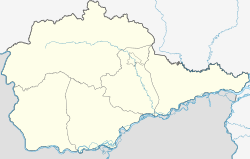Nizhneleninskoye
Нижнеленинское | |
|---|---|
Selo | |
| Coordinates: 47°57′45″N 132°40′08″E / 47.96250°N 132.66889°E | |
| Country | Russia |
| Region | Jewish Autonomous Oblast |
| District | Leninsky District |
| Population | 212 |
| Time zone | UTC+10:00 (VLAT[1]) |
Nizhneleninskoye (Russian: Нижнеле́нинское) is a rural locality (a selo) in Leninsky District of the Jewish Autonomous Oblast.[2] Located on the Amur River, Nizhneleninskoye is the location for the Tongjiang-Nizhneleninskoye railway bridge which crosses over the river to China, joining it by a railway bridge to Tongjiang in Heilongjiang Province.[3]
YouTube Encyclopedic
-
1/3Views:4 4864 226409
-
China's first highway-railway cross-sea bridge sees rail structures connected
-
Chinese section of first China-Russia rail bridge project completed
-
Tongjiang China Russia Heilongjiang Railway Bridge
Transcription
Tongjiang-Nizhneleninskoye railway bridge
The Tongjiang-Nizhneleninskoye railway bridge was proposed in 2007 by Valery Solomonovich Gurevich, the vice-chairman of the Jewish Autonomous Oblast in Russia. The railway bridge over the Amur River will connect Tongjiang with Nizhneleninskoye, a village in the Jewish Autonomous Oblast.[4]
The Chinese portion of the bridge was finished in July 2016.[5] In December 2016, work began on the Russian portion of the bridge in December 2016. The bridge was expected to open in October 2019 but was delayed to late 2021, finally opening on August 17, 2021.[6]
References
- ^ "Статья 6. Распространение информации о точном значении времени и календарной дате / КонсультантПлюс | Федеральный закон от 03.06.2011 N 107-ФЗ (ред. от 22.11.2016) "Об исчислении времени", статья 5". consultant.ru. Retrieved 2018-08-29.
- ^ Законодательное Собрание Еврейской автономной области. Закон №982-ОЗ от 20 июля 2011 г. «Об административно-территориальном устройстве Еврейской автономной области». Вступил в силу через 10 дней после дня официального опубликования. Опубликован: "Биробиджанская звезда", №54, 29 июля 2011 г. (Legislative Assembly of the Jewish Autonomous Oblast. Law #982-OZ of July 20, 2011 On the Administrative-Territorial Structure of the Jewish Autonomous Oblast. Effective as of the day which is 10 days after the day of the official publication.).
- ^ Lilit Marcus. "First cross-river railway bridge between China and Russia completed". CNN. Retrieved 2022-09-15.
- ^ Proposed bridge to boost bilateral trade, China Daily, June 19, 2007.
- ^ Andrew Higgins (July 16, 2016). "An Unfinished Bridge, and Partnership, Between Russia and China". The New York Times. Retrieved July 17, 2016.
- ^ Lilit Marcus. "First cross-river railway bridge between China and Russia completed". CNN. Retrieved 2021-08-23.


